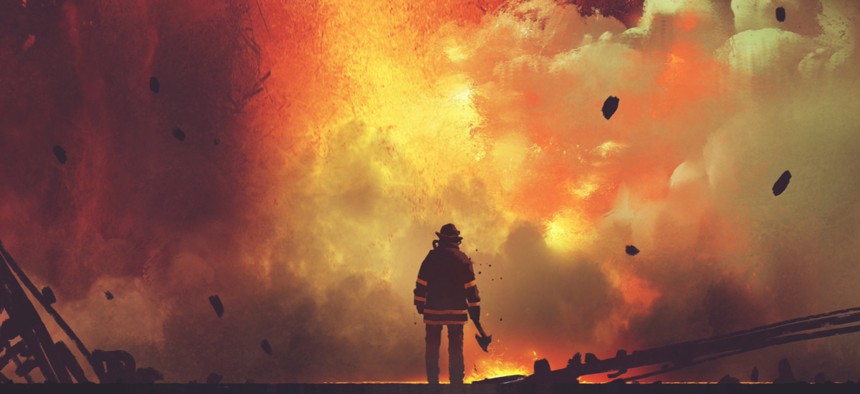A New Way for Firefighters to Track Their Exposure to Carcinogens

A record of exposure can help firefighters in certain states access workers' compensation benefits if they are diagnosed with cancer. Shutterstock
A new app allows firefighters to track in real-time their exposure to dangerous substances.
A new phone app would give firefighters the ability to track their own exposure to carcinogens, creating a detailed personal record of what happened to them at work.
The National Fire Operations Reporting System (NFORS) Exposure Tracker app, launched this month, allows firefighters and other first responders to log details of on-the-job incidents, including exposure to dangerous substances. The app, free for download in both the App Store and on Google Play, is meant to be a record that first responders can access indefinitely, including after they retire.
That’s key, officials said, as states continue to pass legislation authorizing workers’ compensation benefits for firefighters who are diagnosed with cancer after exposure to harmful substances during their careers.
“This valuable tool will help provide fire fighters with the documentation they need to show on-the-job exposure to a toxic soup of carcinogens and ensure they have the resources to get healthy and return to work,” Harold A. Schaitberger, general president of the International Association of Fire Fighters (IAFF), said in a statement.
To date, 47 states have passed legislation that grants compensation to firefighters who are diagnosed with cancer. Twenty of those laws cover firefighters with any type of cancer, while the remaining 13 are more specific, covering diseases like leukemia, brain cancer and non-Hodgkin’s lymphoma.
Firefighters already log details of the fires they respond to and the substances they encounter, typically in a notebook after returning from a call. But the process is tedious, relies entirely on self-reporting and requires fire fighters to know the incident number and date of each dispatch, said Doug Stern, director of strategic campaigns and media relations for IAFF.
“So if I say, ‘On Aug. 2, 2015, I was exposed to smoke,’ that’s not good enough,” he said. “I have to be able to trace it back to the incident number itself.”
The app takes care of that by asking users to select their fire department during the registration process. During each subsequent login, the system pre-populates incident information for each firefighter, allowing users to simply add details, including the type of smoke they encountered (light or heavy, from a car or from a house), whether their gear was already dirty and whether they washed it before or after the fire.
The information is encrypted and is not shared with fire departments. Users have the option to share their anonymized information with the national Firefighter Cancer Registry—a voluntary federal database—and other studies to improve research on the subject.
The technology was a joint venture between NFORS, IAFF, the International Association of Fire Chiefs, the Metropolitan Fire Chiefs Association and the International Public Safety Data Institute. It is funded by the Federal Emergency Management Agency's Assistance to Firefighters grant program and the Ramsey Social Justice Foundation.
The app is just the latest innovation in a string of measures designed to reduce the risk of cancer for firefighters, including simple practices like washing gear and showering immediately after fires to remove soot from their skin, Stern said.
“As we become more and more aware of the dangers our firefighters are facing, they’re getting better and better at taking care of themselves,” he said. “It’s not one thing that's ever going to make a difference, but as long as we’re doing a bunch of little things, we’re going to get there."
Kate Elizabeth Queram is a Staff Correspondent for Route Fifty and is based in Washington, D.C.
NEXT STORY: Cities and States Continue to Face Challenges with Rape Kit Backlogs





